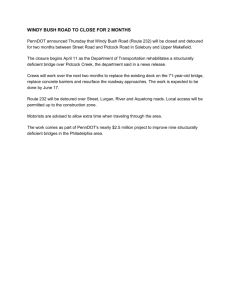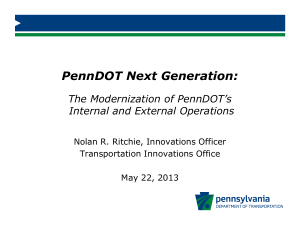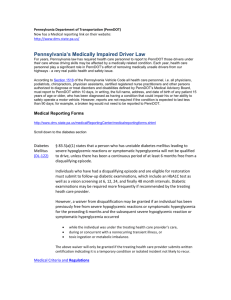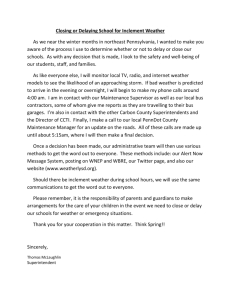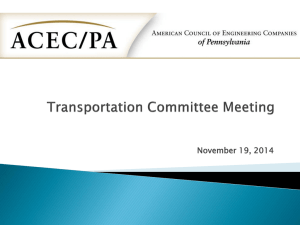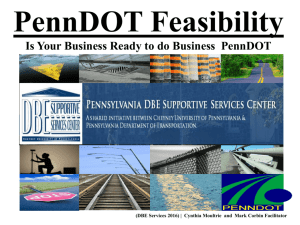2015 Transportation Performance Report State Transportation Commission www.talkPAtransportation.com
advertisement
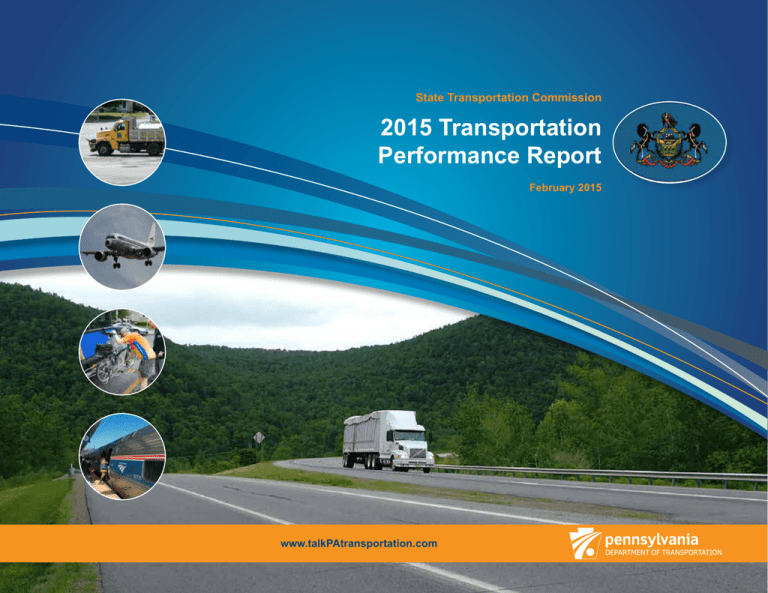
State Transportation Commission 2015 Transportation Performance Report February 2015 www.talkPAtransportation.com PA Transportation Performance Safety Mobility Impaired Driving Fatalities Congestion Airport Enplanements Unbelted Fatalities Highway Capacity Public Transportation Ridership Aggressive Driving Fatalities Traveler Information Amtrak Ridership Distracted Driving Fatalities Traffic Signals Freight Movement Pedestrian Fatalities Traffic Incident Management Freight Demand Work Zone Crashes Key Preservation State Bridges Accountability Next Generation Savings Local Bridges Resource Sharing Posted Bridges Innovation Pavement Condition Project Delivery Rail Infrastructure Transit Performance Transit Infrastructure Transit Modernization Color indicates STATUS Performance is low due to magnitude of need and years of underinvestment. Performance is adequate; however, opportunities for improvement exist. Performance is good due to current initiatives and available resources. Angle indicates TREND improving steady worsening See next page for summary descriptions. 2 Summary Safety Mobility Preservation Accountability $80,000 Funding Twelve Year Program Funding Levels millions $60,000 Multimodal Rail Freight $40,000 Aviation Public Transportatio $20,000 Highway and Bridg Transportation safety remains a top PennDOT priority. Funding is targeted toward improving infrastructure, educating users, and enforcing traffic laws. Fatalities are at the lowest level in decades. However, any loss of life on Pennsylvania’s roadways is unacceptable. Emerging technologies such as connected and autonomous vehicles create new challenges and opportunities for the future of transportation. Legislative opportunities can help support transportation safety. Recent studies include recommendations for automated speed enforcement in work zones and transportation incident management. Moving people and goods effectively, efficiently, and reliably is foundational to Pennsylvania’s quality of life and economy. Congestion levels in Pennsylvania are fairly steady. New efforts to strategically expand capacity and improve transportation operations will help to further improve travel. PennDOT’ s vigorous investment in public transportation has resulted in strong levels of ridership in recent years. Act 89 of 2013 established a new Multimodal Fund which aids in the movement of people and goods by all modes. Pennsylvania’s transportation infrastructure is vast and requires significant attention to maintain. Act 89 of 2013 provides PennDOT the funding to keep pace with this large system’s preservation and renewal needs. New investment levels equate to a continued reduction in structurally deficient bridges, improved roadway pavements, and enhanced public transportation and rail freight facilities. Through the use of innovative materials, processes, and partnerships, PennDOT is implementing infrastructure that is more sustainable, longer lasting, and cost effective. Maximizing resources and modernizing business processes produces substantial cost savings and provides for more efficient operations. PennDOT is committed to accountability for results and transparency of operations. Cost savings from PennDOT’s modernization initiatives are increasing every year, with $100 million saved in 2014. Delivering on-time and on-budget transportation projects translates into greater user benefits as well as getting the most out of every transportation dollar invested. With more than 50 PennDOT Next Generation modernization teams, the culture of advancing performance continues to expand and produce results. 0 2011 2013 2015 Source: PennDOT Center for Program Development With the passage of Act 89 of 2013, Pennsylvania has the opportunity to begin meeting its transportation needs. Funding for the Twelve Year Program of multimodal transportation improvements, which had been declining until 2013, is now trending upward. Public transportation investment has increased dramatically between 2003 and 2014. PennDOT’s expanded public-private partnerships are leveraging resources in innovative ways. However, uncertainties in federal funding create doubts for the future. Focused federal funding for reconstruction of the Interstate Highway System should be an important priority for reauthorization. 3 XX Highway fatalities are at their lowest level since the 1920s. PennDOT is working toward zero deaths by setting aggressive goals of reducing fatalities and injuries by half over the next two decades. Safety Safety Planning: 1,208 fatalities on Pennsylvania highways in 2013 1,471 706 Safety Implementation: Five-Year Average Highway Fatalities 2005-2009 2009-2013 • Engineering infrastructure improvements such as high friction surfaces and cable median guide rail. • Enforcement of traffic safety laws. • Education aimed at improving driver behavior. • Emergency Services plans to enhance response time, communications, and coordination. 2026-2030 • Data-driven deployment of cable median guide rail reduces 60% of crossover fatalities. • Fatalities in intersection crashes are the lowest in 20 years due to intersection improvements. • Automated Red Light Enforcement (ARLE) grant funds have great impact on local road safety. A Safety Symposium was held in 2014. Seat belt laws, ignition interlocks for DUI offenders, automated speed enforcement in construction zones, and young driver safety were highlighted. Source: PennDOT 2014 State of Highway Safety Summary Report Safety Planning Safety Implementation Progress Issues Technology: Automakers and the transportation industry are working together to develop new technologies that will improve transportation safety. Vehicles are now being implemented with collision warning systems, lane departure warning systems, blind spot detection, and adaptive headlights. Safety Legislation: Legislative opportunities can support transportation safety. Independent studies regarding automated speed enforcement in work zones and transportation incident management have recommended legislative action to enhance and improve transportation safety. Technology Safety Legislation Future Smart Vehicles: Smart Vehicles Government agencies, researchers, and the private sector are working together to advance research in the areas of connectivity, mobility, and autonomous vehicles. While the basic components of this technology are in place, issues involving consumer acceptance and legal matters must be resolved. It is estimated these developments will provide opportunities to enhance transportation safety over the next decade. 4 Impaired driving remains an education and enforcement target. • Almost 31% of fatalities are attributable to driving under the influence (DUI). • The 369 alcohol-related fatalities in 2013 were the lowest since recordkeeping began in the 1980s. However, there could be more enforcement aimed at first-time offenders. 600 525 target reduction: 411 400 369 people died in alcohol-related crashes in 2013 200 Five-Year Average Alcohol-Related Driving Fatalities 0 2005-2009 2009-2013 2013-2017 Source: PennDOT 2014 State of Highway Safety Summary Report Seat belts are saving lives. • In 2013, seat belt use improved to 84% due to enforcement and education. • Pennsylvania is one of 17 states that does not have a primary seat belt law. Nationwide, states with a primary seat belt law have a usage rate of 90%. • If Pennsylvania were to pass a primary seat belt law, usage could rise 6.4%, which could save about 52 lives, 766 serious injuries, and $227 million in costs each year. 600 Primary seat belt laws allow law enforcement officers to ticket a driver or passenger for not wearing a seat belt—without any other traffic offense taking place. Source: Governors Highway Safety Association 567 target reduction: 448 400 Data Source: 425 unrestrained fatalities in 2013 200 Five-Year Average Unrestrained Fatalities 0 2005-2009 2009-2013 2013-2017 Source: PennDOT 2014 State of Highway Safety Summary Report 5 Aggressive driving reduction remains a focus. • Almost 12% of all 2013 fatalities involved aggressive driving. 200 • Participating police agencies are targeting 400 corridors where aggressive driving is likely. 150 176 target reduction: 140 145 people died in aggressive driving crashes in 2013 100 50 0 Five-Year Average Aggressive Driving Fatalities 2005-2009 2009-2013 2013-2017 Source: PennDOT 2014 State of Highway Safety Summary Report Distracted driving is trending down, but remains a critical issue. • Distracted driving is an evolving concern due to new technology. • Strategies include highway measures such as centerline and edge-line rumble strips, enforcing the anti-texting law, and public education. 100 93 target reduction: 73 75 74 distracted/drowsy driver fatalities in 2013 50 25 0 Data Source: Five-Year Average Distracted/Drowsy Driver Fatalities 2005-2009 2009-2013 2013-2017 Source: PennDOT 2014 State of Highway Safety Summary Report 6 Pedestrian fatalities remain fairly constant with a targeted reduction. Data Source: • Low-cost enhancements include better signs and pavement markings. 200 • PennDOT provides “Yield to Pedestrian” signs to local municipalities. 150 • Philadelphia received a federal grant to improve pedestrian safety through expanded public education and enforcement initiatives. 153 target reduction: 125 151 pedestrian fatalities in 2013 100 50 0 Five-Year Average Pedestrian Fatalities 2005-2009 2009-2013 2013-2017 Source: PennDOT 2014 State of Highway Safety Summary Report Work zone crashes have increased in recent years. • Work zone crash rates are not consistent with overall crash trends. • The TAC report Cameras in Work Zones recommends automated enforcement to improve safety. • Work zone cameras have proven to be effective in reducing speeds. Maryland and Illinois are currently using automated enforcement. 2,000 1,845 1,787 1,500 16 people died in work zone crashes in 2013 1,000 500 PENNSYLVANIA STATE TR ANSP ORTATION ADV ISORY COMMIT TEE CAMERAS IN WORK ZONES Work Zone Crashes (includes fatal and non-fatal crashes) 0 2006 2010 FINAL REPORT 2013 NOV E M B E R 2 0 12 Source: PennDOT 2014 State of Highway Safety Summary Report 7 Mobility XX Moving people and goods efficiently, affordably, and reliably is vital to Pennsylvania’s economic prosperity and quality of life. Multimodal System: People use all transportation modes for commuting and conducting business, pursuing education, and accessing healthcare. The demand for transporting raw materials, finished products, and packages requires a robust multimodal freight system. Through Act 89, advances are being made in the operation of all modes and intermodal connectivity. Sponsorship: As part of a Public-Private Partnership agreement, State Farm sponsors roving service patrols. This service offers free motorist assistance on expressways in the Lehigh Valley, Harrisburg, Philadelphia, and Pittsburgh regions. Multimodal System Sponsorship Capacity: Several strategic highway capacity enhancements are now in development. It is critical to make the best use of all modes and maximize the capacity of existing facilities. Freight: Forecasts estimate that freight tonnage moving in Pennsylvania will nearly double by 2040. This could strain the capacity of multiple modes unless technology and new capacity management methods are introduced. Progress Issues Capacity Freight Future Collaboration Collaboration: The transportation industry is working with stakeholders from various disciplines to develop programs aimed at combatting capacity and congestion issues affecting our transportation infrastructure. The PublicPrivate Partnership program connects the public and private sectors of transportation. Regional transit consolidation is also being explored by PennDOT and its transit partners. 8 Congestion in major urban areas has held steady in recent years. 60 • PennDOT is using a variety of strategies and technologies to improve congestion on expressways and major thoroughfares. 40 52 Philadelphia 48 Data Source: 44 Pittsburgh 39 URBANMOBILITY REPORT • PennDOT is developing additional measures to manage congestion and plan for mitigation strategies. 20 Annual Hours of Delay per Commuter 0 2007 2009 2011 DECEMBER 2012 2012 Source: 2012 Annual Urban Mobility Report POWERED BY REGION UNIVERSITY TRANSPORTATION CENTER Strategic improvement projects are gradually adding highway capacity. • While highway mileage remains nearly steady, total travel demand (in miles traveled) has been at reduced levels since 2008. Travel Demand vs. Highway Capacity miles 150,000 Total Miles of Highway 100,000 250 Daily Vehicle Miles Traveled million DVMT • Act 89 enabled the inclusion of several strategic capacity enhancement projects in the 2015 – 2026 Twelve Year Program. 500 200,000 50,000 0 2003 2008 2013 0 Source: PennDOT Bureau of Planning and Research 9 Traveler information is available through new user-friendly tools. • Free traveler information is available through a variety of digital tools. The number of PA 511 website users increased 3½ times in 2014. • PennDOT launched the 511 mobile application in May 2014. It offers hands-free traveler information based on the user’s GPS location. • 2.2 million people dialed 511 to receive traveler information in 2014. 80,000 Traveler Information Users 70,000 60,000 511PA Mobile App Downloads 50,000 40,000 Twitter Followers 30,000 20,000 E-mail Alert Subscribers 10,000 0 Jan 2012 Jan 2013 Jan 2014 Nov 2014 Source: PennDOT Bureau of Maintenance and Operations A new municipal partnership program is designed to improve safety and mobility by improving traffic signals. • Improvements to traffic signal operation and efficiency are underway through a partnership between PennDOT and municipalities. Green Light–Go Program Funding • In the first year of the Green Light-Go program, 323 traffic signals will be upgraded. $40 million $25 million $10 million 2014 2015 In the first year of the Green Light-Go program, 323 traffic signals will be upgraded. 2016 Source: PennDOT Bureau of Maintenance and Operations 10 Traffic Incident Management (TIM) is improving through strategic coordination and technology. • PennDOT is focusing on improving response to traffic incidents by realigning TIM regions, completing a new Regional Traffic Management Center in Clearfield, and planning to locate the Statewide Traffic Management Center in PEMA’s new facility. • Along with the Traffic Operations Center at the Pennsylvania Turnpike Commission, TMCs are used to continuously monitor traffic conditions of all major Pennsylvania roadways. PROPOSED PennDOT RTMC Regions Interstates Other Limited-Access Toll Roads NY Other NHS Roads PennDOT District Boundary Philadelphia Metro (non-PA) 86 79 Central Region (includes all of I-80) ERIE 90 19 97 18 6 OH 8 1-0 81 62 198 McKEAN NY TIOGA SUSQUEHANNA 6 WAYNE CRAWFORD BRADFORD WARREN 6 POTTER 4-0 LACKAWANNA FOREST 322 79 58 62 15 CAMERON ELK 62 18 80 CLARION 80 60 108 8 LAWRENCE JEFFERSON 10-0 208 BUTLER 79 60 322 ARMSTRONG 147 76 453 MIFFLIN 70 70 76 119 9-0 76 FAYETTE CUMBERLAND 33 5-0 LEHIGH 61 581 322 22 378 309 222 8-0 283 15 BERKS LEBANON 422 222 176 76 YORK 6-0 309 MONTGOMERY 1 276 95 63 76 476 676 LANCASTER ADAMS 70 CHESTER 1 DELAWARE 322 95 43 Western Region Eastern Region Southeastern Region MD STMC – Statewide Traffic Management Center BUCKS 476 100 202 83 TMC – Traffic Management Center TOC – Traffic Operations Center 100 30 FRANKLIN FULTON SOMERSET 79 81 76 76 GREENE 422 HUNTINGDON 99 BEDFORD 12-0 81 PERRY BLAIR WESTMORELAND 78 DAUPHIN 22 66 43 79 80 SCHUYLKILL 22 JUNIATA 219 376 CAMBRIA 209 93 NORTHAMPTON INDIANA 422 MONROE 81 80 CARBON NORTHUMBERLAND SNYDER ALLEGHENY WASHINGTON 42 54 22 322 279 22 220 PIKE 476 MONTOUR UNION 28 6 739 191 423 29 11 80 80 80 CENTRE 380 309 COLUMBIA 422 11-0 507 LUZERNE 180 15 CLEARFIELD 153 219 8 19 220 488 68 LYCOMING CLINTON 80 879 BEAVER 3-0 2-0 8 VENANGO 11 84 MERCER 62 Proposed TIM Regions 6 WYOMING SULLIVAN 358 RTMC – Regional Traffic Management Center County Boundary 90 Traffic Incident Management Acronyms LEGEND Major Roadways: NJ Source: PennDOT Bureau of Maintenance and Operations PEMA – Pennsylvania Emergency Management Agency WV VA Airport enplanements remain strong. • PennDOT administers state and federal funding for airport improvements. • To remain competitive and attract jobs, Pennsylvania eliminated the 6% sales tax on aircraft parts and maintenance. • Each year, 6.5 million visitors arrive in Pennsylvania via commercial airports, generating economic activity. 25 million 20 million 24,000,724 passengers 20,133,790 passengers 15 million 10 million Pennsylvania Statewide Enplanements 5 million 0 2000 2007 2013 Source: PennDOT Bureau of Aviation 11 Public transportation ridership remained strong over the past decade. • Ridership is trending upward but has been impacted by severe weather and service reductions implemented prior to the passage of Act 89. • Transit customers will experience service improvements and fewer fare hikes with the additional funds provided through Act 89. • The opportunity continues for transit system consolidations to reduce costs. 500 million 375 million 427,343,689 passengers 408,875,932 passengers 250 million Fixed-Route Transit Ridership by State Fiscal Year 125 million 0 2006-07 2009-10 2011-12 2013-14 Source: PennDOT Bureau of Public Transportation Amtrak Keystone Corridor ridership has grown substantially since Fiscal Year 2004-05. • Infrastructure improvements on the Keystone Corridor between Harrisburg and Philadelphia make train travel an appealing alternative to driving. • PennDOT and Amtrak are collaborating with communities along the corridor to integrate station improvements with local revitalization and economic development. 1,500,000 1,348,619 passengers 1,000,000 500,000 0 764,126 passengers 2004-05 Amtrak Keystone Corridor Ridership by State Fiscal Year 2009-10 2013-14 The Keystone Corridor accommodates higher-speed rail with train speeds reaching 110 mph. Source: PennDOT Bureau of Public Transportation 12 Freight movement: Companies depend on an integrated, agile, and efficient freight network. Major Flows by Truck To, From, and Within Pennsylvania: 2007 • Pennsylvania moves 7% of the nation’s goods (by weight in tons). • Pennsylvania moves 9% of the nation’s goods (by value in dollars). • PennPORTS coordinates statewide port policy and works with Pennsylvania ports to maximize their operations for the benefit of the state’s economy. Source: FHWA Office of Freight Management and Operations, Freight Analysis Framework, v.3.1.2, 2011 Major Freight Flows by Truck to, from, and within Pennsylvania, 2007 Freight demand is estimated to grow by 66% by 2040. Note: Major flows include domestic and international freight moving by truck on highway segments with more than twenty five FAF trucks per day and between places typically more than fifty miles apart. Source: U.S. Department of Transportation, Federal Highway Administration, Office of Freight Management and Operations, Freight Analysis Framework, version 3.1.2, 2011. • Pennsylvania’s multimodal transportation system moved 1.2 billion tons of goods in 2011, valued at more than $1.6 trillion. This is projected to grow to 2 billion tons by 2040. • By 2040, tonnage of goods moved in Pennsylvania is expected to increase by 74% for truck freight and 45% for rail freight. • Air freight is often low volume but high value, making airports an important component of the freight system. Pennsylvania Freight Tonnage by Mode Water: 5% Water: 4% Pipeline: 0.15% Air: 0.02% Pipeline: 0.23% Air: 0.01% Rail: 14% Rail: 16% Truck: 78% Truck: 82% 2011: 1.2 billion tons 2040: 2 billion tons (projected) Source: PA On Track: Pennsylvania’s Long-Range Transportation & Comprehensive Freight Movement Plan 13 Preservation and Renewal Rapid Bridge Replacement Project: Pennsylvania bridges are getting a boost from the Rapid Bridge Replacement Project, a Public-Private Partnership (P3) to replace 558 deficient bridges. Construction will begin by Summer 2015 with replacements completed within 36 months. The P3 team is responsible for maintaining the bridges for 25 years after replacement. The accelerated pace of construction will minimize mayb XX Act 89 brings unprecedented transportation investment. inconvenience for the traveling public. The project will save money through economies of scale, and it will relieve PennDOT from maintenance costs for these structures for 25 years. Public Transportation: Act 89 provides public transportation with a significant increase in funding that helps transit systems to plan for and achieve a state of good repair. Rapid Bridge Replacement Public Transportation Progress Issues Future Number of Deficient Bridges Pavement Conditions New Materials Bundling Local Bridge Projects New Materials: Advanced materials and construction methods will improve infrastructure sustainability and durability. As an example, PennDOT is implementing Long-Life Concrete Pavement Number of Deficient Bridges: Significant progress is being made reducing the number of structurally deficient bridges in Pennsylvania. Act 89 funding will enable this progress to continue through the Rapid Bridge Replacement Project and an expanded Bridge Rehabilitation and Replacement Program. Pavement Conditions: Pennsylvania pavements are getting renewed attention and are smoother, on average. However, portions of the system such as the Interstates have exceeded their life expectancy and are in need of complete reconstruction. The cost of doing so must be addressed over time and the federal government needs to provide additional resources to this national system. specifications that are anticipated to considerably extend service life. Bundling Local Bridge Projects: Bundling local bridge projects results in rapid delivery and cost savings through economies of scale. 14 PennDOT is making significant progress reducing structurally deficient (SD) state-owned bridges. • The number of SD bridges has decreased from 6,034 in 2008 to 4,019 in 2014. However, 16% of statemaintained bridges are still structurally deficient. 7,000 • The average age of a bridge in Pennsylvania is 50 years old. 3,500 5,672 5,250 projection: 3,740 Number of State-Owned Structurally Deficient Bridges Greater than 8 Feet Long 1,750 0 4,019 bridges were structurally deficient in 2014 2005 2014 2017 Source: PennDOT Bridge Management System Deficiencies on locally-owned bridges remain high. • 35% of local bridges are structurally deficient. 2,500 • The Local Bridge Bundling program is being expanded to additional regions. 2,218 2,048 Number of Locally-Owned Structurally Deficient Bridges Greater than 20 Feet Long 1,250 0 2007 2011 2014 Source: PennDOT Bridge Management System 15 After spiking in 2014, the number of weight-restricted bridges is being reduced through new funding for bridge rehabilitation. • A more stringent bridge posting procedure was implemented in 2013 to ensure bridge safety and preserve aging bridges. This change increased the number of posted bridges. • New investment is being directed to rehabilitate or replace posted bridges, which will reduce the number of weight-restricted structures. 1000 895 (March 2014) 846 (December 2014) 825 750 target reduction: 718 500 Number of Posted State Bridges 250 0 2003 2008 2014 2017 Source: PennDOT Bridge Management System Pavement condition improved over the past year. • The percentage of pavements rated “poor” decreased in 2014 after several years of increases. • 8,821 miles of road have pavement rated as “poor” and are in need of rehabilitation or reconstruction. • 50% of Interstate highways have exceeded their design life and should be reconstructed. This is costly and will require federal support. 50% of Interstate highways need to be reconstructed. 50 Percentage of Roadways Statewide with Pavement Smoothness Rating of “Poor” 20.2% of pavement was rated “poor” in 2014 25 target reduction: 20.0% 16.1% 0 2009 2010 2011 2012 2013 2014 2015 2016 2017 Source: PennDOT Bureau of Maintenance and Operations 16 Predictable funding is now available to invest in rail freight infrastructure. • Grants are provided through the Rail Transportation Assistance Program, a capital bond-funded program, and the Rail Freight Assistance Program, funded through the Multimodal Fund. • Act 89’s Multimodal Fund provides reliable funding for the Rail Freight Assistance Program. • Approximately $1 million per year from the Marcellus Shale Impact Fees is invested in rail projects. Rail Freight Grants State Share by Year $50 million $41.6 million $25 million $17.5 million 0 2003 2008 2014 Source: PennDOT Bureau of Rail Freight Grants were provided to 39 rail freight improvement projects in 2014. The investment will help sustain nearly 34,000 Pennsylvania jobs. Increased, predictable funding is available for transit infrastructure. • Act 89 provided public transportation with a significant increase in capital funding that helps transit systems plan for and address state-of-good-repair issues and implement technology improvements. • An Asset Inventory and Planning Tool is being developed to assist transit agencies in reporting and planning for capital assets. $600 million $300 million 0 Public Transportation Capital Funding by Fiscal Year $560 million $254 million 2007-08 2014-15 2020-21 Source: PennDOT Bureau of Public Transportation 17 Accountability $20 million in new estimated savings identified in 2014. 75% of employee ideas for improvements submitted via “IdeaLink” are considered implementable. 50 project teams reviewed, approved, and implemented new policies, processes, procedures, and programs. 30 state agencies are participating in “Mapping the Future,” an initiative to promote collaboration, streamline operations, and share resources. XX Transportation agencies are maximizing resources and modernizing business processes. Next Generation: PennDOT’s Next Generation (PNG) initiative provides a fresh review of policies, processes, procedures, and programs to improve functions, create new efficiencies, refresh and advance business practices and technology, and create a culture of continuous improvement. STIC: The State Transportation Innovation Council (STIC) is a cross section of transportation stakeholders who come together to forge an environment of innovation, imagination, and ingenuity. STIC pursues specific initiatives and rapid implementation to deliver a modern, high-quality transportation system. Source: PennDOT Bureau of Innovations Next Generation STIC Progress Issues Future Changing Technology: Technology is changing rapidly. Breakthroughs in autonomous vehicles and related technologies will change the way transportation products and services are provided. Changing Technology Modernization Cost Savings Modernization: PennDOT must continue to provide leadership and collaboration to its partners in continuing to modernize transportation products and services. Cost Savings: Transportation agencies must continue to find cost savings opportunities and efficiencies over the next decade. 18 Next Generation is saving dollars to reinvest in the transportation system. • PennDOT eliminated nearly 60 redundant engineering reviews to save more than $8 million over the next 10 years. Annual Savings from Modernization $100 million $80 million • PennDOT Driver License Examiners now use iPads to administer the driver skills test, eliminating redundant system entry and reducing transaction time by 20 to 30 minutes. $60 million • The Pennsylvania Driver’s Manual was updated in cooperation with State Farm and Sheetz, saving printing costs. 2012 2013 2014 Source: PennDOT Bureau of Innovations Resource sharing saves money and improves transportation operations and customer service. • PennDOT is better balancing human resources needs with distribution of work duties by geographic area. Allowing employees to cross county and PennDOT District boundaries results in significant cost savings and efficiencies. • PennDOT is also sharing resources with other agencies, such as co-locating with the Pennsylvania Turnpike Commission at its Donegal maintenance site rather than maintaining separate facilities. 40,000 35,000 Hours Shared Across Regions 36,707 30,000 25,000 25,266 20,000 15,000 10,000 5,000 0 2009 2010 2011 2012 Source: PennDOT Bureau of Innovations 2013 The Turnpike Commission and PennDOT are exchanging services in the Dupont, Wyoming Valley area. PennDOT is providing the Turnpike with the use of a salt storage building and in return the Turnpike is supplying PennDOT with salt brine. 19 Innovation is growing through the leadership of the State Transportation Innovation Council. Source: PennDOT Bureau of Planning and Research • The map displays innovations or new techniques promoted by the State Transportation Innovation Council (STIC) and implemented across the state. • For example, Safety Edge is a 30-degree angle at the outside edge of roadway pavement. Compared to the vertical drop-off of a traditional edge, Safety Edge is more durable and enables vehicles to return to the roadway more safely. High Friction Surface Treatments (HFST) are a low-cost safety improvement proven to reduce crashes on wet pavements and curves. Since HFST was installed at a location on Route 611 in Northampton County, wet pavementrelated crashes have dropped from 22 (in the 10 years prior to the treatment) to zero (over the 5 years it has been installed). PennDOT emphasizes accountability for on-time and on-budget project delivery. • Project delivery is a combined effort of PennDOT staff, consultants, and contractors. Highway Construction Project Delivery 2009 On Time 96% 2010 96% 67% 2011 93% 67% 2012 95% 69% 2013 96% 65% 2014 95% 75% 0 On Budget 100 0 Source: PennDOT Bureau of Project Delivery 69% 100 20 Transit Performance: Pennsylvania’s transit operators recover 35% of their operating expenses through the farebox. 70 • Performance reviews of transit providers are conducted on a five-year cycle. The assessment makes transit agencies aware of improvement opportunities and identifies best practices. 60 Percentage of Operating Expenses Recovered through Fares 50 35% 40 Bus fares and other transit ticket sales only cover a portion of the cost to provide transit service. This ratio (known as farebox recovery) is better in Pennsylvania than in most other states. 30 20 10 0 NH NJ DC NV NY IL PA ME AK VA MA CA GA HI MN WI IN PR VT SC OR WA IA OH FL MD UT RI WV CO NC CT TN MO KS AZ NE MI WY KY MS LA AR ND MT TX SD OK DE NM AL ID VI • Act 89 requires every transit system to have a policy for how the agency adjusts fares to account for inflation. Source: Federal Transit Administration, National Transit Database, 2013 Transit Modernization: Counties and transit systems are exploring regionalization. • The merger of the Berks Area Regional Transit Authority (BARTA) and the Red Rose Transit Authority (RRTA) in Lancaster is the largest consolidation to date. • Consolidating single-county transit systems into multicounty agencies can result in streamlined administration, economies of scale in procurement, and overall cost savings. This can reduce the local match and enhance public transportation. ERIE WARREN McKEAN Consolidated transit systems WAYNE FOREST WYOMING ELK VENANGO CAMERON SULLIVAN LACKAWANNA LYCOMING MERCER CLARION CLINTON COLUMBIA CLEARFIELD BUTLER UNION CENTRE MONROE MONTOUR CARBON ARMSTRONG SNYDER BEAVER NORTHUMBERLAND NORTHAMPTON SCHUYLKILL MIFFLIN INDIANA PIKE LUZERNE JEFFERSON LAWRENCE Studying consolidation SUSQUEHANNA BRADFORD TIOGA POTTER CRAWFORD LEHIGH JUNIATA ALLEGHENY CAMBRIA BLAIR PERRY WESTMORELAND DAUPHIN HUNTINGDON WASHINGTON LEBANON BERKS MONTGOMERY The BARTA and RRTA consolidation will save the counties $4.7 million over five years. BUCKS CUMBERLAND LANCASTER SOMERSET GREENE FAYETTE FULTON BEDFORD YORK FRANKLIN CHESTER DELAWARE PHILADELPHIA ADAMS Source: PennDOT Bureau of Public Transportation 21 Funding XX With the passage of Act 89, Pennsylvania is on track to implement necessary improvements. Act 89 Additional Annual Investment Transportation Asset 2014 By Year 5 State Roads and Bridges $800 million $1.3 billion Public Transportation $207 million $480 - $495 million Local Roads and Bridges $37 million $237 million PA Turnpike Expansion Projects $27 million $86 million Multimodal Fund $60 million $144 million Dirt/Gravel/ Low-Volume Roads $15 million $30 million $1.1 billion $2.3 - $2.4 billion Total Act 89: The General Assembly adopted Act 89 in November 2013. This historic legislation established predictable funding for all transportation modes. Implementation of this act is phased over a five-year period. Multimodal Fund: Act 89 established a Multimodal Fund providing grants for all modes of transportation. Act 89 Multimodal Fund Progress Issues Future Federal Funding: The uncertainty of federal funding for transportation threatens to undermine the tremendous gains of Pennsylvania’s new funding program. This is particularly true with respect to the Interstate System, which has traditionally been a federal responsibility. Federal Funding approximately 50,000 new jobs and Pennsylvania Economy preserve 12,000 Local Roads and Bridges jobs. Pennsylvania’s economy is highly dependent on an efficient transportation Pennsylvania Economy: system. By the fifth year of Act 89 implementation, the Local Roads and Bridges: additional investment Local governments will is projected to create benefit from Act 89. Full implementation will provide an additional $237 million in liquid fuels funds. In addition, there will be $40 million in annual grants to improve traffic signals, a $35 million dirt and gravel roads program, and up to 100% savings for municipalities that participate in local bridge bundling. 22 The state transportation budget totals $8.1 billion for Fiscal Year 2014-15. Transportation Budget • Approximately half of the transportation budget is dedicated to state highways and bridges. Dollars in thousands 2% 5% • Federal funds provide 25% of the budget; the remainder is from Commonwealth sources. 8% 9% 51% 24% $4,173,685 Highway and Bridge $2,003,137 Multimodal, Public Transportation, Rail Freight, and Aviation $726,423 Payments to Local Governments $666,548 State Police $414,380 Debt and Other Agencies $197,638 Safety and Licensing Source: PennDOT Bureau of Fiscal Management The Twelve Year Transportation Program is expanding for all modes. • Highway and bridge as well as public transportation funding is being expanded through Act 89. State Transportation Commission 2015 Twelve Year Twelve Year Program Funding Levels $60,000 millions • Pennsylvania’s Twelve Year Program is funded by a combination of federal and state funds. The federal portion is uncertain due to the Spring 2015 expiration of the federal transportation legislation. $80,000 The State Transportation Commission successfully modernized Twelve Year Program development cycles. PROGRAm august 2014 Multimodal Rail Freight $40,000 Aviation Public Transportation $20,000 Highway and Bridge 0 2011 2013 www.talkPatransportation.com 2015 Source: PennDOT Center for Program Development 23 Act 89 stabilized the State Motor License Fund. • The largest source within the Motor License Fund (MLF) is the fuel tax. The balance of the fund had been declining due to inflationary pressures pushing construction project costs higher, lower demand for fuel, and more fuelefficient vehicles. $5 billion $4.95 billion (projected) $3.48 billion Would be $3.33 billion without Act 89 $2.5 billion $2.75 billion State Motor License Fund Revenue by Fiscal Year 0 2003-04 2013-14 2018-19 Source: PennDOT Bureau of Fiscal Management Act 89 established a new Multimodal Fund, which: • Stabilizes funding for ports and rail freight. • Increases funding for aviation. • Establishes a dedicated funding source for bicycle and pedestrian projects. • Includes a discretionary fund for priority transportation investments. Multimodal Fund FY 2013-14 FY 2014-15 FY 2015-16 FY 2016-17 Aviation $ 5 million $ 6 million $ 6 million $ 6 million Rail Freight $8 million $10 million $10 million $10 million Passenger Rail $6 million $8 million $8 million $8 million Ports and Waterways $8 million $10 million $10 million $10 million Bicycle and Pedestrian $2 million $2 million $2 million $2 million PennDOT Discretionary $0 $20 million $40 million $40 million Commonwealth Financing Authority Discretionary $0 $40 million $85 million $85 million $29 million $96 million $161 million $161 million Total Projected Funds Source: PennDOT Bureau of Fiscal Management 24 Public-private partnerships (P3) allow PennDOT to collaborate with the private sector to positively impact projects and services. • The Public-Private Partnership Act (Act 98 of 2012) authorizes PennDOT to enter into agreements with the private sector to participate in the delivery, maintenance, and financing of transportation-related projects. • PennDOT has pursued strategic opportunities to partner with the private sector to cost-effectively advance statewide goals. Four examples are highlighted. Rapid Bridge Replacement Project This P3 project will accelerate replacement of 558 structurally deficient bridges. The Plenary Walsh Keystone Partners must begin construction by Summer 2015 and complete replacements by August 31, 2018. The private entity is responsible for maintaining each bridge for 25 years after replacement. This project maximizes efficiencies and economies of scale. It aids in maintaining system connectivity and mobility for commerce. 511 PA Traffic and Traveler Information Project Information Logistics, Inc., was selected to develop, operate, and maintain the next generation 511 system for PennDOT. This led to the release of a mobile application which provides functionality and safety benefits, including traffic flow maps and hands-free, eyes-free notification for smart phone users. PennDOT savings are estimated at $1.2 million for the first year of operation and $1.5 million annually thereafter. State Farm Freeway and Service Patrol Compressed Natural Gas (CNG) Infrastructure for Transit State Farm is sponsoring roving safety patrols offering free motorist assistance on expressways in the Philadelphia, Pittsburgh, Harrisburg, and Lehigh Valley areas. This sponsorship offsets nearly 11% of the annual cost to operate the service. This P3 project will bring CNG fueling infrastructure to transit agencies across the Commonwealth as they transition from diesel fleets to natural gas buses and vehicles. This also benefits the vendor, which will be able to sell CNG more broadly to the public and other private fleets. Source: PennDOT Public Private Partnerships Office 25 Pennsylvania’s Mass Transit Assistance steadily grows. • Mass Transit Assistance has more than doubled since Fiscal Year 2003-04. • Predictable funding allows transit agencies to plan for future investments in stations, maintenance facilities, and fleet upgrades. $1,570,756 $1,500,000 millions • Stable funding prevents crippling service cuts and ensures that the vital needs of those depending on transit are met. $2,000,000 $1,000,000 Mass Transit Assistance by Fiscal Year $500,000 $765,492 0 2003-04 2009-10 2014-15 Source: PennDOT Bureau of Fiscal Management Federal Interstate funding is inadequate. • Pennsylvania’s Interstate System has reached the end of its useful design life. Rebuilding will require substantial investment. • The Interstate System was established as a federal–state partnership. • The federal share is in doubt. Legislation is required to provide policy and stable funding beyond Spring 2015. 80 70 68 miles of Interstate highway need to be reconstructed each year 60 50 Miles of Interstate Reconstructed Actual Funded vs. Need 40 30 20 19.5 miles reconstructed 6.7 miles reconstructed 10 0 2007 2008 2009 2010 2011 2012 Interstate modernization is an appropriate federal role. 2013 Source: PennDOT Bureau of Maintenance and Operations 26 Sources XX This report draws on data collected and analyzed by various units of PennDOT and our federal and state partners. PennDOT USDOT Bureau of Aviation Federal Highway Administration Bureau of Fiscal Management Office of Freight Management and Administration, Freight Analysis Framework Bureau of Innovations Bureau of Maintenance and Operations Bureau of Planning and Research Bureau of Project Delivery Federal Transit Administration National Transit Database Bureau of Public Transportation Bureau of Rail Freight Center for Program Development and Management Public Private Partnerships Office Transportation Advisory Committee Other Texas A & M Transportation Institute 2012 Annual Urban Mobility Report 2014 State of Highway Safety Summary Report Cameras in Work Zones PA on Track: Pennsylvania’s Long-Range Transportation and Comprehensive Freight Movement Plan 2015 Twelve Year Program Bridge Management System Contact the State Transportation Commission: 717-787-2913/RA-PennDOTSTC@pa.gov For general inquiries: Julie Harmantzis, Executive Secretary For specific information regarding: Transportation Planning . . . . . . . . . . . . Transportation Performance Report . . . Public Outreach . . . . . . . . . . . . . . . . . . . Data Inquiries . . . . . . . . . . . . . . . . . . . . Mark Tobin Jessica Clark Terry Pinder Martin Sargent 27 Acknowledgements Honorable Leslie S. Richards, Chair Acting Secretary, PA Department of Transportation Honorable Frederic M. Wentz, Esq. Vice Chairman McGrory-Wentz, LLP Montgomery County Honorable Robert B. Pease, P.E., Secretary National Development Corporation (ret.) Allegheny County Honorable Cristina G. Cavalieri, Esq. Thomas Jefferson University Philadelphia County Honorable Edward J. Cernic, Sr. Cernic’s Suzuki-Honda Motorcycles Cambria County Honorable Ronald J. Drnevich Gannett Fleming, Inc. (ret.) Capital Blue Cross (ret.) Dauphin County XX State Transportation Commission Honorable William F. Keller (Meredith Biggica, Alternate) Minority Chairman of the Transportation Committee PA House of Representatives Honorable George M. Khoury, III, P.E. PennDOT (ret.) Centre County Honorable James D. Kingsborough Exterior Building Solutions, LLC Cumberland County Honorable Sharon L. Knoll Sharon L. Knoll Associates Erie County Honorable John C. Rafferty, Jr. (Nathan Spade, Alternate) Majority Chairman of the Senate Transportation Committee Honorable John Taylor (Eric Bugaile, Alternate) Majority Chairman of the Transportation Committee PA House of Representatives Honorable John N. Wozniak (Josh Myers, Alternate) Minority Chairman of the Transportation Committee PA Senate Honorable Charles H. Martin Commissioner Bucks County Honorable Frank E. Paczewski Ertley Dealerships Luzerne County 28 Acknowledgements XX Transportation Advisory Committee Mr. Louis C. Schultz, Jr., Chairman Transportation Consultant Cumberland County Mr. Joseph Mangarella Carol Ann Fashions (ret.) Cambria County Honorable Pedro A. Rivera (Linda Bryant, Alternate) Acting Secretary, PA Department of Education Honorable Leslie S. Richards Acting Secretary, PA Department of Transportation Mr. Joel B. McNeil Brookville Equipment Jefferson County Mr. John (Jack) P. Rutter, P.E. IA Construction Corporation (ret.) York County Roy E. Brant, Ph.D. Edinboro University (ret.) Crawford County Honorable Robert F. Powelson (Rodney Bender, P.E., Alternate) Chairman, Public Utility Commission Mr. Gustave Scheerbaum, III, P.E. City of Philadelphia Honorable Dennis M. Davin (Paul Opiyo, Alternate) Acting Secretary, PA Department of Community and Economic Development Honorable John Quigley (Kelly Heffner, Alternate) Acting Secretary, PA Department of Environmental Protection Mr. Donald L. Detwiler New Enterprise Stone and Lime Co., Inc. Bedford County Honorable John C. Rafferty, Jr. (Nathan Spade, Alternate) Majority Chairman of the Transportation Committee PA Senate Mr. Thomas C. Geanopulos Marketing Consultant (ret.) Allegheny County Mr. John Hanger Director of Planning and Policy Office of the Governor Honorable David S. Hickernell PA House of Representatives District 98 Mr. Larry Segal Impact Pennsylvania Strategies, LLC Delaware County Mr. Jeffrey J. Stroehmann JDM Consultants Union County Michael W. Untermeyer, Esq. William-Michael Associates Philadelphia County Honorable Russell Redding Erin Smith (Alternate) Acting Secretary, PA Department of Agriculture Mr. Ronald G. Wagenmann Manager, Upper Merion Township Montgomery County Mr. Robert T. Regola, III McCormick Taylor Westmoreland County Mr. Charles F. Welker, P.E. EADS Group, Inc. (ret.) Blair County Sean M. Reilly, Esq. Roscommon International, Inc. Philadelphia County 29
